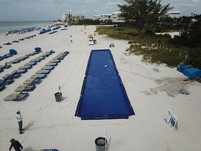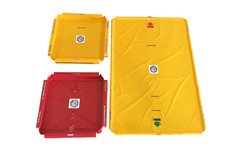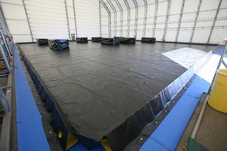By: Scott Sagalow
President
Secondary Containment Tips.
The main things to consider under the EPA’s hazardous waste storage regulation 40 CFR 264.175, aka, “The Secondary Containment Regulations.”
Your secondary containment system must be Leak Free and sturdy enough to contain the spilled liquids.
Regular maintenance and inspection are required.
Ensure all valves and drain plugs are in the correct position for safe operation. Also, make sure there is no damage to the unit. Any damage to the secondary containment unit could prevent the containment berm from doing what you want it to do, containing liquids if the primary container fails. Finally, always check for chemically compatible with whatever liquids you are storing. Chemical compatibility includes all the components of your secondary containment, such as fabric, drains, or other surfaces that may contact the fluids contained.
The primary container must be suspended above the sump. So that it can’t sit in their waste, so your secondary containment unit must be designed to allow the liquid to drain into a sump area so a spill can quickly and easily be removed.
Meeting this requirement is easy when dealing with a tanker truck. When dealing with barrels or other tanks, you can raise them on grates, decking, or wood pallets (Make sure these Items are chemically compatible as well). You can add a drain to your spill berm or other secondary containment units. Drains can be designed to remove a spill or rainwater. In addition, a Ready Passive Filter can aid in storm-water removal if your spill containment is for hydrocarbons.
The sump or containment capacity is the amount of liquid held in the containment or spill berm. It should meet federal, state, and local secondary containment capacity requirements.
Remember to account for any slope in the area.
The secondary containment “must have a minimum capacity of at least 10% of the total volume of all the primary containers or 110% of the largest container, whichever is greater.”
For example, if you have two 55-gallon drums in your containment. You have a total volume of 110 gallons.
10% of the total of all the containers (two 55-gallon drums) is 11 gallons. (10% of 110 gallons)
110% of the largest container stored is 61 gallons.
Sixty-one gallons is greater than 11 gallons, so you need to have secondary containment for 61 gallons.
Remember containment capacity is stated on a level surface, and most surfaces are not level.
When your secondary containment unit is outdoors, you must consider rainwater, snowmelt, or other liquids that will displace the containment system’s capacity. If possible, install the containment system under a shelter or cover.
If it is impossible, you will need to consider possible wind, snow, and rainwater issues and add this to your calculated capacity requirements.
Inspect and remove any liquid or other obstruction in your secondary containment area to prevent overflow.
Please check out the below products to help with your secondary and spill containment requirements.
Secondary Containment Products
Ready Spill Containment Products:









